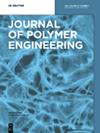超临界二氧化碳和碱处理对热塑性淀粉/聚乙烯醇膜阻氧性能的影响
IF 1.7
4区 工程技术
Q4 POLYMER SCIENCE
引用次数: 0
摘要
摘要通过naoh处理和超临界二氧化碳(scCO 2)辅助处理,混合适当的PVA负载,成功制备了可持续的氧屏障热塑性淀粉(TPS)/聚乙烯醇(PVA)吹膜。naoh处理的TPS或scCO 2 TPS膜的自由体积空腔特性(FVCC)和氧透过率(OTR)均小于未经适当碱处理的TPS或scCO 2 TPS膜。naoh处理的sco2 TPS膜的OTR和FVCC值比未经sco2辅助制备的naoh处理的TPS膜小。当PVA负载接近溶解度极限值27.5% wt%时,经适当碱处理的sco2 TPS的所有OTR和FVCC值都明显下降到最小值。一个重要的结果是,最佳的naoh处理的PVA - z膜的OTR仅为3.1 cm 3 /m 2 day atm,满足高氧屏障塑料的要求。PVA z膜对naoh处理的sco2 TPS的动态分子弛豫和WAXD模式检测表明,PVA与TPS是相容的,PVA负载≤溶解度极限值。在碱处理和scCO 2辅助处理过程中加入适当的PVA负荷,从而增强了TPS和PVA的羟基之间的分子相互作用,从而显著降低了经naoh处理的scCO 2 TPS的OTR和FVCC。本文章由计算机程序翻译,如有差异,请以英文原文为准。
Effect of super critical carbon dioxide and alkali treatment on oxygen barrier properties of thermoplastic starch/poly(vinyl alcohol) films
Abstract Sustainable oxygen barrier thermoplastic starch (TPS)/polyvinyl alcohol (PVA) blown films were successfully prepared by blending proper PVA loads during NaOH-treating and supercritical carbon dioxide (scCO 2 ) assisted processing. The NaOH-treated TPS or scCO 2 TPS films showed smaller free-volume-cavity characteristics (FVCC) and oxygen transmission rate (OTR) than those of TPS (or scCO 2 TPS) prepared without proper alkali-treatment. Smaller OTR and FVCC values were detected for NaOH-treated scCO 2 TPS films than those of NaOH-treated TPS films prepared without scCO 2 -assistance. All OTR and FVCC values detected for proper alkali-treated scCO 2 TPS y PVA z films diminished distinctly to a smallest value, when their PVA loads came near a solubility limit value of 27.5 wt%. An essential result is that the OTR of the optimal NaOH-treated scCO 2 TPS y PVA z film is merely 3.1 cm 3 /m 2 day atm, which meets the requirement of high oxygen barrier plastics. Dynamic molecular relaxations and WAXD patterns detected for proper NaOH-treated scCO 2 TPS y PVA z films disclosed that PVA was compatible with TPS, as PVA loads were ≤ the solubility limit value. The distinctly reduced OTR and FVCC detected for optimal NaOH-treated scCO 2 TPS y PVA z films are partially attributed to the reinforced molecular interactions between hydroxyl groups of TPS and PVA, as they were blended with proper PVA loads during their alkali-treating and scCO 2 -aid processing.
求助全文
通过发布文献求助,成功后即可免费获取论文全文。
去求助
来源期刊

Journal of Polymer Engineering
工程技术-高分子科学
CiteScore
3.20
自引率
5.00%
发文量
95
审稿时长
2.5 months
期刊介绍:
Journal of Polymer Engineering publishes reviews, original basic and applied research contributions as well as recent technological developments in polymer engineering. Polymer engineering is a strongly interdisciplinary field and papers published by the journal may span areas such as polymer physics, polymer processing and engineering of polymer-based materials and their applications. The editors and the publisher are committed to high quality standards and rapid handling of the peer review and publication processes.
 求助内容:
求助内容: 应助结果提醒方式:
应助结果提醒方式:


